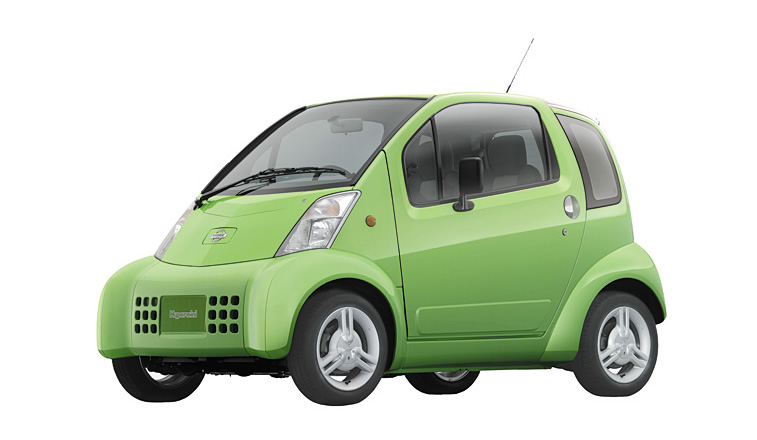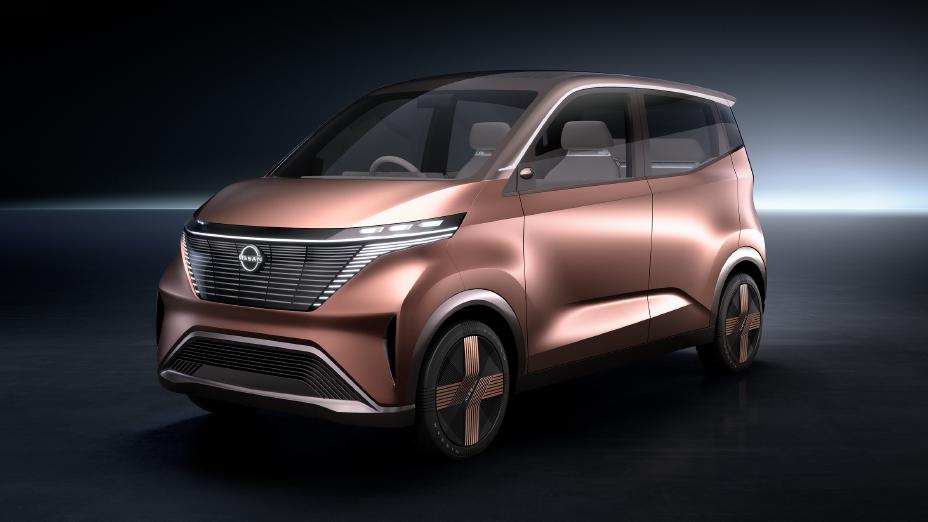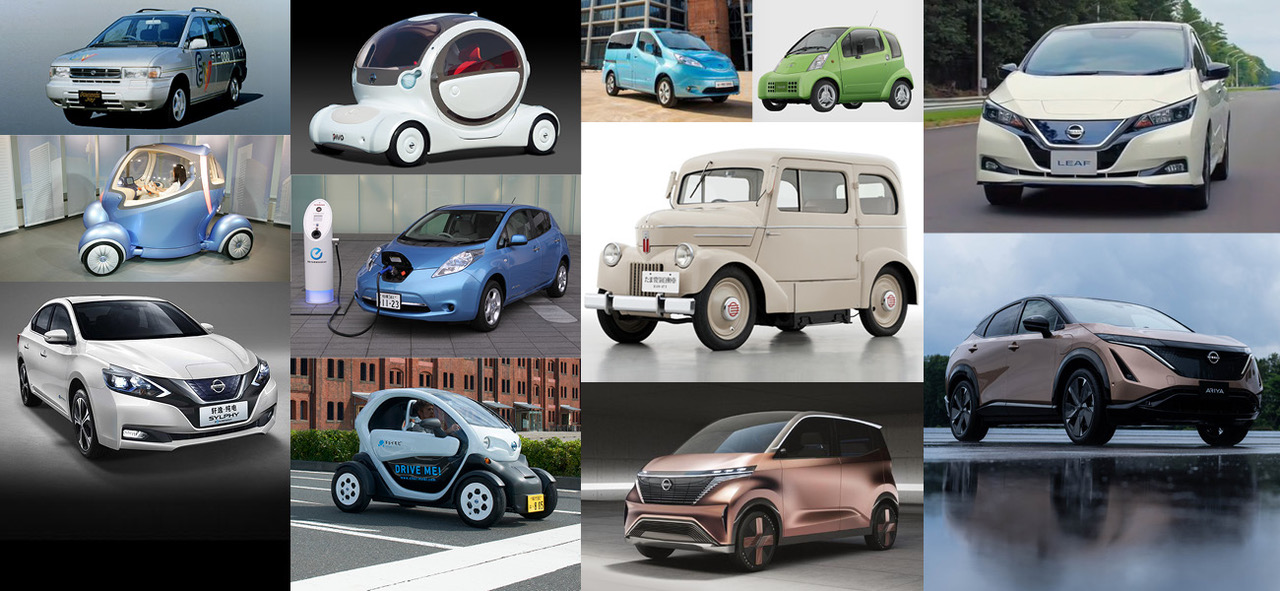
A car is more than just a way to get around. Getting behind the wheel should be inspiring, exciting and just plain fun – and the shift to electric vehicles doesn’t change that one bit. In fact, thanks to smarter onboard technology, today’s electric vehicles open up richer lifestyle possibilities than ever.
Nissan was a pioneer in creating electric cars for modern living. From our first EV in 1947 to the new Nissan Ariya, from ice cream vans to robot co-pilots, our electric-powered lineup has changed with the times and drivers’ needs.
To celebrate the 10th anniversary of the Nissan LEAF, our first mass-produced, 100% electric car, we’re taking a drive down memory lane to revisit 12 groundbreaking models from Nissan’s history of electric vehicle development.
INDEX
- Tama Electric Vehicle (1947): Nissan’s first electric car
- Prairie Joy EV (1996): World‘s first lithium-ion battery-powered car
- Hypermini (2000): The head-turning movie star
- Pivo (2005): A radical new concept for electric mobility
- Pivo 2 (2007): Electric urban commuter to keep drivers positiv
- Nissan LEAF (2010): Bringing EVs to the mainstream
- Nissan New Mobility Concept (2010): Tackling social issues with EV technology
- e-NV200 (2014): Nissan’s first mass-produced all-electric commercial vehicle
- New Nissan LEAF (2017): Raising the bar
- Sylphy Zero Emission (2018): Manufactured in China, for China
- IMk (2019): Chic design, next-generation driver support
- Ariya (2020): All-new EV delivers driving excitement, confidence, comfort and connectivity
Tama Electric Vehicle (1947) Nissan’s first electric car

Electric vehicles aren’t a new idea. In postwar Japan, where oil was scarce but hydroelectric power was relatively plentiful, the government promoted research and development in this area. Nissan’s engineers rose to the challenge with the Tama Electric Vehicle.
Released in 1947, the Tama was Nissan’s very first electric car. Used mainly by taxi companies, it had replaceable lead–acid batteries that gave it a top speed of 35.2 kph and a range of 96.3 kilometers. These results are modest by today’s standards, but they made the Tama the highest performer in government trials. By 1950, the oil supply had stabilized and the Tama was discontinued – but Nissan’s EV research went on.
Prairie Joy EV (1996) World‘s first lithium-ion battery-powered car

Lithium-ion batteries first appeared in devices like laptops and cellphones. Some doubted they could ever be scaled up to power a whole car, but the Prairie Joy EV, the world’s first electric vehicle equipped with cylindrical-type lithium-ion battery power, proved itself in one of the most challenging environments on earth: the Arctic. Japan’s National Institute of Polar Research used the Prairie Joy EV for six years under harshpolar conditions, without a single breakdown. Because it was silent and emission-free, the car allowed researchers to get closer to wildlife for observation.
Under normal driving conditions, the Prairie Joy EV’s batteries delivered 200 km of range and a top speed of 120 kph. Thirty Prairie Joy EVs were sold in all, to corporate and fleet customers in Japan.
Hypermini (2000) The head-turning movie star

The Hypermini was a new take on the electric car: an urban commuter vehicle built for two. Stylish and distinctive, it appeared in Hollywood movies like “Sleepover” and “The Princess Diaries 2.” A neodymium magnet synchronous traction motor delivered a zippy 100 kph at top speed and up to 115 km of range on a single charge.
The Hypermini received the New Energy Grand Prize from Japan’s New Energy Foundation and a Good Design award from the Japan Institute for Design Promotion. An innovative keyless entry system also made it the vehicle of choice for car-sharing pilot projects from Yokohama to the University of California, Davis.
Pivo (2005) A radical new concept for electric mobility

The Pivo was a next-generation concept EV displayed at the 2005 Tokyo Motor Show. Its bubble-like cabin attracted attention, and it was also notable as the first vehicle to be powered by light, compact laminate lithium-ion batteries. The cute original character Pivo-chan, designed by Takashi Murakami, was also popular.
The Pivo was designed for young, urban women looking for their dream car for daily life. Built for three, the cabin could rotate in either direction so that instead of backing up, the driver simply turned the cabin around and drove the other way. Typical Nissan touches included the ability to control the sound system and GPS with fingers on the steering wheel, for greater safety. Monitors on either side of the windshield displayed the area beyond them to reduce blind spots. The Pivo also had omnidirectional video monitoring – an early version of Intelligent Around View Monitor, now available in many Nissan vehicles.
Pivo 2 (2007) Electric urban commuter to keep drivers positive

Research shows that drivers in a happy, positive mood have fewer accidents. The Pivo 2 was an experiment in applying this insight, with an onboard Robotic Agent system that monitored driving conditions and used speech and motion to help the driver stay cheerful.
Independent control of all four wheels helped the Pivo 2 minimize lean during acceleration or turning, for added safety. The wheels could even turn 90 degrees to let the Pivo 2 drive sideways into parking spots.
Nissan LEAF (2010) Bringing EVs into the mainstream

As Nissan’s first mass-produced electric vehicle, the Nissan LEAF was a milestone for electric mobility. More than 500,000 LEAF cars have been built to date.
The key to the LEAF’s success was combining decades of research and development with consumer insight. The first-generation LEAF had a range of 200 km per charge, making it a practical option for many first-time electric vehicle buyers. The Nissan LEAF also introduced the far-reaching idea of using an electric vehicle as a mobile power source.
In 2016, for a commemorative event, a special Nissan LEAF was made that detected the brainwaves of the driver and projected their feelings as cartoon sound effects alongside the vehicle as it drove around a driving school course.
Nissan New Mobility Concept (2010) Tackling social issues with EV technology

As the developed world’s population ages and one-person households grow in number, mobility needs will shift toward shorter trips for fewer passengers. To show how those needs might be met, Nissan developed the New Mobility Concept: a user-friendly, ultra-compact, emissions-free 100% electric vehicle with the maneuverability of a motorcycle and the stability of a car.
The City of Yokohama is already putting these ideas into practice. Choimobi Yokohama is a car-sharing scheme that uses the New Mobility Concept to make life easier for tourists and revitalize local communities. As a bonus, the program lets first-time drivers experience the fun and convenience of an ultra-compact EV for themselves.
e-NV200 (2014) Nissan’s first mass-produced all-electric commercial vehicle

Ever bought ice cream from an electric van? If you’re in the U.K., you might have encountered Mackie’s all-electric ice cream van, based on the e-NV200 — Nissan’s first zero-emission light commercial vehicle.
Available in Europe and Japan, the e-NV200 offers the roominess and versatility of the popular NV200 Vanette with a quiet, powerful electric drivetrain. The hydraulic, regenerative braking system gives the vehicle a range of up to 190 km per charge. The e-NV200 can also serve as a mobile battery, complete with a power socket, making it useful for everything from disaster response to outdoor promotions – and even ice cream sales.
New Nissan LEAF (2017) Raising the bar

The new LEAF featured updates across the board: more powerful acceleration, lighter handling and a vastly increased range of up to 400 km per charge. The new model supports drivers with features like ProPILOT advanced driver assistance; ProPILOT Park, which handles parallel parking; and e-Pedal, which lets the driver accelerate, decelerate and stop using a single pedal.
In 2019, the Nissan LEAF e+ was added for more power and more range. It was the first LEAF model to include a newly developed electric powertrain that boosted both power and range. The “e+” in the name also refers to another improvement: a larger 62 kilowatt-hour battery that boosted the car’s range by 40%.
As a showcase for Nissan’s forward-thinking approach to electric mobility, the new Nissan LEAF has been a platform for other ideas since its release. The Nissan LEAF Dream Drive mimics the drone of a regular engine – absent in electric vehicles – to help frazzled parents get children to sleep. In 2019, a new Nissan LEAF was turned into a Christmas tree with hundreds of exterior lights, to show how much power the regenerative energy system can recover.
Sylphy Zero Emission (2018) Manufactured in China, for China

The Sylphy Zero Emission was the first Nissan-branded EV specifically for the Chinese consumers, manufactured in China.
Based on core technologies from the Nissan LEAF, with the batteries moved under the seating, the midsize Sylphy ZE sedan has a full-sized wheelbase for even more stability and reliability, as well as a spacious cabin with best-in-class legroom. Its range on a single charge is 338 km by Chinese government standards.
IMk (2019) Chic design, next-generation driver support

The IMk concept EV was unveiled at the 2019 Tokyo Motor Show. With a “kei car” body size and all-new EV platform, the IMk offered a powerful, smooth and quiet drive augmented by driver support systems for environments ranging from city streets to major expressways.
Designed for connectivity, the IMk was seamlessly linked to both the driver and the world outside. The IMk could even connect to calendar and schedule management software to offer up-to-the-minute guidance on when to leave for the next destination and how to avoid congestion on the way.
Ariya (2020) All-new EV delivers driving excitement, confidence, comfort and connectivity

So, what is Nissan’s newest EV? It’s the Nissan Ariya!
Revealed in Nissan’s first ever virtual launch, the 100% electric crossover was first hinted at with the Ariya Concept, displayed at the 2019 Tokyo Motor Show.
The Ariya represents Nissan’s future design direction and its latest technological advancements, promising drivers a seamless, intuitive and adaptive experience that supports their lifestyles both on- and off-board. The Ariya’s design was inspired by traditional Japanese aesthetic ideals. The car’s sleek exterior is like nothing else on the road. With a spacious, open interior and a maximum range of 610 km, it fits into just about every modern lifestyle niche, from everyday commuting to extended weekend outings. Omnidirectional monitoring, ProPILOT 2.0, e-Pedal and e-4ORCE* complete the picture with cutting-edge driver support.
- e-4ORCE will be available on the 4WD version
To see more about Nissan’s electric vehicles, please visit Nissan EV Heritage Photo Gallery.









